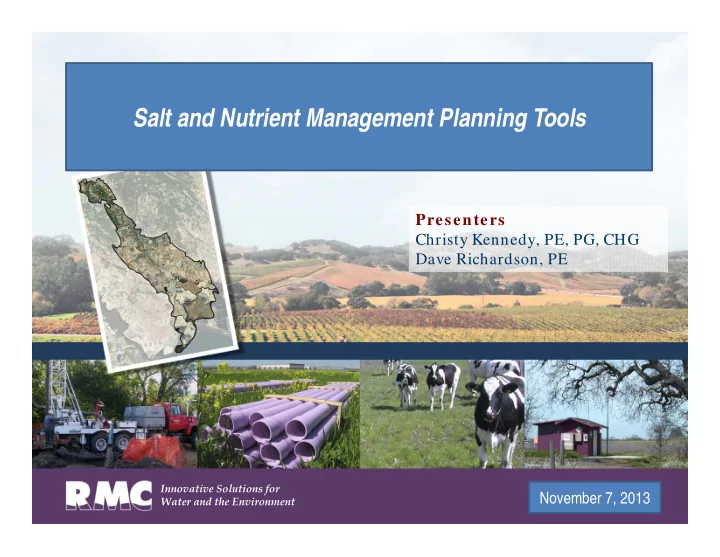

Implementing Salt and Nutrient Management Plan Salt and Nutrient Management Planning Tools for the Sonoma Valley County Sanitation District Presenters Christy Kennedy, PE, PG, CHG Dave Richardson, PE Innovative Solutions for July 28, 2011 November 7, 2013 Water and the Environment
RMC’s SNMP Experience • Northern California • Sonoma Valley • Santa Rosa Plain • Santa Clara Valley Water District (outreach support) • Bay Area IRWMP SNMP Template • Central Coast • Paso Robles • Southern California • Antelope Valley • Temecula Valley • Water Replenishment District of So. Cal.: Central and West Basins • Coachella
SNMP Approach within Several Regions (18-month Process) Oct. 2012 Mar. TAC TAC Apr. Jun.TAC Loading Results Loading Results BAP Jul.2013 Potential Source Potential Source Anti-degradation Anti-degradation Implementation Implementation BAP Work Identification Identification Analysis Analysis RW & RW & Measures Measures shop 4 Stormwater Stormwater Salt & Nutrient Salt & Nutrient Work Work Work Work shop 1 shop 2 shop 3 Plan Compilation Plan Compilation shop 6 Goals & Goals & Work Land Use Land Use Objectives Objectives Draft GW Draft GW Integration into Integration into shop 5 Verification Verification Monitoring Plan Monitoring Plan Bay Area IRWMP Bay Area IRWMP Assimilative Assimilative Capacity, Fate & Capacity, Fate & Jan. 2013 Transport Transport TAC Final Plan & June 2012 BAIRWMP Document TAC Workshop 5 with Bay Area Coordinating committee
GIS Model – Ties Basin Characteristics to Load Estimates ET Precipitation and Applied Water Demand Runoff Recharge/ Water Storage Demand Salt Load Related Factors and Attributes Nutrient Load
Salt and Nutrient Analysis Platform (SNAP!) • SNAP enables users to: • Evaluate loading factors impacting basin loading rates • Test loading sensitivity of various factors • Evaluate spatial distribution of loading (real or hypothetical scenarios) • BMP evaluation • Basins management changes • Data visualization for analysis, QA/QC and outreach
Loading Approach Is Highly Dependent on Land Use List of Landuse • Agricultural Commodities • Park (Private) • Apartments • Park/Other Recreational Facility (City) Loading Landuse Landuse Factors • Auto Sales • Park/Other Recreational Facility (County) • Banks • Park/Other Recreational Facility (State) • Dairy • Crop Coefficient • Burial Property • Parking Lots (Private) • City Government Properties • Pastures • Golf • Irrigation • Clubs/Lodge Halls • Processing Plants • Irrigated Agriculture • Fertilizer/Amendment • County Government Properties • Professional Buildings • Dance Halls (Private) • Religious Properties • Irrigated Vine (Salts) • Duplexes and Doubles • Residential Common Areas • Non-Residential Urban • Livestock (Salts) • Federal Government Properties • Restaurants and Bars • Field Crops • Roadways • Non-irrigated • Fertilizer/Amendment • Food Stores • Rural Residences Agriculture (Nutrients) • Golf Courses (Private) • School District Property • Hardwoods and Chaparral • Schools • Parks and Camps • Livestock (Nutrients) • Homes • Service Shops • Residential • Uptake/Offtake • Horse Ranches • Service Stations • Hospitals (Private) • Shopping Centers • Rural Residential (Nutrients) • Hotels • Single Family Dwellings • Schools • Other losses (Nutrients) • Irrigated Dairies • Special Districts Properties • Irrigated Orchards • Specialty Farms • Vacant • Municipal Inputs (Salts) • Irrigated Pastures • State Government Properties Commercial/Industrial • Municipal Inputs • Irrigated Poultry Ranches • Store and Office Combinations/Single Story • Irrigated Vineyards • Stores • Vacant Residential (Nutrients) • Light Manufacturing • Theaters • Water • Lumber • Three and Four Unit Complexes • Mfg Home/Trailer Parks • Tidelands • Mineral Processing • Transitional Use • Miscellaneous Commercial Spaces • Utilities • Miscellaneous Industrial • Vacant Commercial Land • Motels • Vacant Industrial Land • Non-irrigated Vineyards • Vacant Residential Land • Nurseries • Volunteer Fire Departments • Office Buildings • Warehouses • Orchards • Wastelands • Orphanages • Water Sources • Outdoor Recreational Facilities (Private)
GIS Model Structure is Based on Two Primary Data Integration Processes Fertilizer/ Irrigation Source Water Land Use Amendment Requirements Quality Requirements Other Loads Septic Septic Land Use Other (Infrastructure, System Data Loads Load Data Loads etc) Nutrient Salt Soil Module Textures Module Nutrient Salt Load Load
Loading Model – Draft Input
Loading Model – Data Input
EXAMPLE Loading Factors Other CAFOs Urban Residential Ranchettes Vines
Model Issues and Assumptions • Land Use : How do you capture growth? Cropping changes? • Groundwater : Is your data representative? Is your data for the deep aquifer, but private users are tapping shallow? • Applied Sources : Compare to county sales data, but requires professional judgment. What is applied and what should be applied are often different. • CAFOs: Requires understanding of production areas, application areas, and ponds
Incorporating the Loading • Loading from the surface is only one component • Estimate basin concentrations by mass balance with: • Stream recharge/discharge • Artificial recharge • Subsurface groundwater flow • Leaks • Seawater intrusion/connate water • Groundwater model can be help identify flow volumes
Basins lacking Groundwater Data • GIS can be used with “fuzzed” data locations from CDPH, GAMA, USGS, other • Spatial averaging • 1-bucket approach • Monitoring Plan!
Challenges/Concerns Across the State • Lack of data/lack of access to data – confidentiality • Finger pointing • Calibration • Stakeholder participation • Confusion of how to implement, CEQA or no CEQA? • Differences in Water Quality Objectives
Key Opportunities with SNMPs • Utilizing GMP or IRWM Stakeholder network as working group • Utilizing relationships with USGS • Engagement with RWQCBs throughout process • Get to know your loaders – the best data comes directly from the source • Look at first generation of plans, refine goals & objectives and develop a more standardized approach for Plan development and implementation • Use the SNMP to promote projects
Questions? Christy Kennedy: ckennedy@rmcwater.com, 415.321.3400 Dave Richardson: drichardson@rmcwater.com, 925.627.4100
Recommend
More recommend